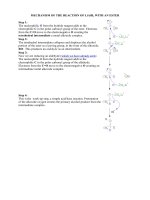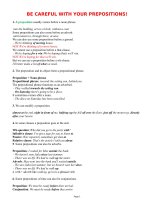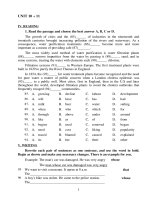Kerr black holes with scalar hair
Bạn đang xem bản rút gọn của tài liệu. Xem và tải ngay bản đầy đủ của tài liệu tại đây (24.79 MB, 48 trang )
Kerr black holes with scalar hair
Φ
lev
ole
Angular Momentum
Mass
Strangeness
Charge
Gravitational and
Baryons
Leptons
electromagnetic waves
Scalar waves
[and
I*
Φ?
111.
Φ?
'0. !' Javil'
Φ?
Φ?
I-B)
I bv »!
Mass
Charge
Angular Momentum
Figurative representation of a black hole in action. All details of the infalling matter
are washed out. The final configuration is believed to be uniquely determined by
mass, electric charge, and angular momentum.
Figure 1
C. Herdeiro
31
Departamento de Física da Universidade de Aveiro, Portugal
PHYSICS TODAY / JANUARY 1971
Downloaded 24 Nov 2012 to 136.159.235.223. Redistribution subject to AIP license or copyright; see />
New Frontiers in Dynamical Gravity, Cambridge, 24 March 2014
based on arXiv:1403:2757 with E. Radu
Slide 1/16
R. Price, i s "
P
log t
This disappearance of the dipole
takes place according to the same kind
of law as the fadeout of perturbations of the quadruoole and higher
moments of the mass distribution.
The collapse leads to a black hole
endowed with mass and charge and
angular momentum but, so far as we can
now judge, no other adjustable parameters: "a black hole has no hair."
Make one black hole out of matter;
the possibility of measuring baryon
number, and therefore this quantity can
not be well defined for a collapsed object. Similarly, strangeness is no longer
conserved.
The “no-hair”
idea
Angular momentum
36
The third property of a black hole is
angular momentum. When it is nonzero, the geometry becomes more complicated. One deals with the Kerr solution2 to the field equations instead of
the Schwarzschild solution. There are
two interesting surfaces associated with
the Kerr geometry, the "surface of in-
process can be so arranged tha
emerging fragment has more ene
infinity than the original particle
The extra energy is effectivel
tracted from the rotational ener
the black hole. If a particle ca
through the ergosphere and escap
some of the energy and angula
mentum of the black hole, it is als
that a particle that is captured c
crease the energy and angular
mentum of the black hole. Capt
possible when the particle pass
sufficiently close to the black hole
critical impact is smaller for a c
PHYSICS TODAY / JANUARY 1971
Downloaded 24 Nov 2012 to 136.159.235.223. Redistribution subject to AIP license or copyright; see />
Ruffini, Wheeler (1971)
Misner, Thorne, Wheeler (1973)
Original idea:
collapse leads to equilibrium black holes uniquely determined by M,J,Q asymptotically measured quantities subject to a Gauss law
and no other independent characteristics (hair)
Motivated by uniqueness theorems
e.g: Israel 1967, 1968; Carter 1970; Hawking 1972; Robinson 1975, 1977; and many others
Overview: “Four decades of black hole uniqueness theorems” D. Robinson (2004, 2009)
Slide 2/16
Hairy black hole solutions exist (D=4, asymptotically flat):
Early example: Einstein-Yang-Mills theory
Bizón 1990; Kunzle and Masood-ul-Alam, 1990; Volkov and Galtsov, 1990
Other examples were obtained in: Einstein-Skyrme, Einstein-Yang-MillsDilaton, Einstein-Yang-Mills-Higgs, Einstein-non-Abelian-Proca, etc
Review by Bizón 1994; Volkov and Gal’tsov (1999)
Slide 3/16
Hairy black hole solutions exist (D=4, asymptotically flat):
Early example: Einstein-Yang-Mills theory
Bizón 1990; Kunzle and Masood-ul-Alam, 1990; Volkov and Galtsov, 1990
Other examples were obtained in: Einstein-Skyrme, Einstein-Yang-MillsDilaton, Einstein-Yang-Mills-Higgs, Einstein-non-Abelian-Proca, etc
Review by Bizón 1994; Volkov and Gal’tsov (1999)
Picture of hairy black holes as bound states of BHs with gravitating
solitons...
Ashtekar, Corichi and Sudarsky (2001)
Slide 3/16
Hairy black hole solutions exist (D=4, asymptotically flat):
Early example: Einstein-Yang-Mills theory
Bizón 1990; Kunzle and Masood-ul-Alam, 1990; Volkov and Galtsov, 1990
Other examples were obtained in: Einstein-Skyrme, Einstein-Yang-MillsDilaton, Einstein-Yang-Mills-Higgs, Einstein-non-Abelian-Proca, etc
Review by Bizón 1994; Volkov and Gal’tsov (1999)
Picture of hairy black holes as bound states of BHs with gravitating
solitons...
Ashtekar, Corichi and Sudarsky (2001)
...but, apparently, no bound state of boson stars with (hairless) BHs.
Slide 3/16
Boson stars:
Kaup (1968); Ruffini and Bonazzola (1969)
Review: Liebling and Palenzuela (2012)
Einstein-KleinGordon theory:
1
S=
16πG
�
4
√
�
ab
∗
2
∗
d x −g R − g ∂a Φ ∂b Φ − µ Φ Φ
�
Slide 4/16
Boson stars:
Kaup (1968); Ruffini and Bonazzola (1969)
Review: Liebling and Palenzuela (2012)
Einstein-KleinGordon theory:
Rotating
boson stars:
1
S=
16πG
2
ds = −e
2F0 (r,θ)
2
dt + e
Yoshida and Eriguchi (1997)
Schunck and Mielke (1998)
�
�
√
4
ab
∗
2
∗
d x −g R − g ∂a Φ ∂b Φ − µ Φ Φ
2F1 (r,θ)
�
2
2
dr + r dθ
2
�
�
+ e2F2 (r,θ) r2 sin2 θ (dϕ − W (r, θ)dt)
Φ = φ(r, θ)ei(mϕ−wt)
Three input parameters: (w,m,n)
Slide 4/16
2
Boson stars:
Kaup (1968); Ruffini and Bonazzola (1969)
Review: Liebling and Palenzuela (2012)
Einstein-KleinGordon theory:
Rotating
boson stars:
1
S=
16πG
2
ds = −e
2F0 (r,θ)
2
dt + e
Yoshida and Eriguchi (1997)
Schunck and Mielke (1998)
�
�
√
4
ab
∗
2
∗
d x −g R − g ∂a Φ ∂b Φ − µ Φ Φ
2F1 (r,θ)
�
2
2
dr + r dθ
2
�
�
+ e2F2 (r,θ) r2 sin2 θ (dϕ − W (r, θ)dt)
Φ = φ(r, θ)ei(mϕ−wt)
Three input parameters: (w,m,n)
Solutions preserved
by a single helicoidal
Killing vector field:
∂
w ∂
+
∂t m ∂ϕ
Slide 4/16
2
Boson stars phase space (nodeless):
m=1
Mµ
1
0.5
0
0.6
0.7
0.8
0.9
1
w/(mµ)
Slide 5/16
Boson stars phase space (nodeless):
m=1
1
Mµ
Mµ
1
0.5
0.5
m=1
0
0.6
0.7
0.8
w/(mµ)
0.9
1
0
0
0.5
Jµ
2
1
1.5
Slide 5/16
Boson stars phase space (nodeless):
m=1
1
Mµ
Mµ
1
0.5
0.5
m=1
0
0.6
0.7
0.8
0.9
1
0
0
0.5
Jµ
w/(mµ)
Conserved Noether charge:
For rotating boson stars:
Schunck and Mielke (1998)
Convenient parameter:
Q=
�
2
1
drdθdϕj
Σ
1.5
t√
−g
J = mQ
mQ
q≡
J
Slide 5/16
Surfaces of constant scalar energy density
C. H., Radu, 2014 (to appear)
Slide 6/16
Black holes with scalar hair? (no other fields)
Various no (scalar) hair theorems:
Chase 1970
Bekenstein 1972, 1975,...;
(scalar-tensor theories): Hawking 1972... Sotiriou and Faraoni 2011
Slide 7/16
Black holes with scalar hair? (no other fields)
Various no (scalar) hair theorems:
Chase 1970
Bekenstein 1972, 1975,...;
(scalar-tensor theories): Hawking 1972... Sotiriou and Faraoni 2011
Harmonic time dependence: no hairy black hole in spherically
symmetric case Pena and Sudarsky (1997)
Slide 7/16
Black holes with scalar hair? (no other fields)
Various no (scalar) hair theorems:
Chase 1970
Bekenstein 1972, 1975,...;
(scalar-tensor theories): Hawking 1972... Sotiriou and Faraoni 2011
Harmonic time dependence: no hairy black hole in spherically
symmetric case Pena and Sudarsky (1997)
But Kerr has an instability in the presence of a massive scalar
field: the superradiant instability
Slide 7/16
Linear analysis: Klein-Gordon equation in Kerr
�Φ = µ2 Φ
Φ = e−iwt eimϕ S�m (θ)R�m (r)
Radial Teukolsky equation: Teukolsky (1972)
dR�m
=
dr
�
a2 w2 − 2maw + µ2 r2 + A�m +
2
K
∆
�
R�m
∆ ≡ r2 − 2M r + a2
K ≡ (r2 + a2 )w − am
Slide 8/16
Linear analysis: Klein-Gordon equation in Kerr
�Φ = µ2 Φ
Φ = e−iwt eimϕ S�m (θ)R�m (r)
Radial Teukolsky equation: Teukolsky (1972)
dR�m
=
dr
�
a2 w2 − 2maw + µ2 r2 + A�m +
2
K
∆
�
R�m
∆ ≡ r2 − 2M r + a2
K ≡ (r2 + a2 )w − am
Generically one obtains quasi-bound states:
ω = ωR + iωI
critical frequency
wc = mΩH
Slide 8/16
Linear analysis: Klein-Gordon equation in Kerr
�Φ = µ2 Φ
Φ = e−iwt eimϕ S�m (θ)R�m (r)
Radial Teukolsky equation: Teukolsky (1972)
dR�m
=
dr
�
a2 w2 − 2maw + µ2 r2 + A�m +
2
K
∆
�
R�m
∆ ≡ r2 − 2M r + a2
K ≡ (r2 + a2 )w − am
Generically one obtains quasi-bound states:
wI < 0 if wR > wc
ω = ωR + iωI
decay
critical frequency
wc = mΩH
Slide 8/16
Linear analysis: Klein-Gordon equation in Kerr
�Φ = µ2 Φ
Φ = e−iwt eimϕ S�m (θ)R�m (r)
Radial Teukolsky equation: Teukolsky (1972)
dR�m
=
dr
�
a2 w2 − 2maw + µ2 r2 + A�m +
2
K
∆
�
R�m
∆ ≡ r2 − 2M r + a2
K ≡ (r2 + a2 )w − am
Generically one obtains quasi-bound states:
wI < 0 if wR > wc
ω = ωR + iωI
decay
critical frequency
wc = mΩH
wI > 0 if wR < wc
grow
Press and Teukolsky
(1972)
Slide 8/16
Linear analysis: Klein-Gordon equation in Kerr
�Φ = µ2 Φ
Φ = e−iwt eimϕ S�m (θ)R�m (r)
Radial Teukolsky equation: Teukolsky (1972)
dR�m
=
dr
�
a2 w2 − 2maw + µ2 r2 + A�m +
2
K
∆
�
R�m
∆ ≡ r2 − 2M r + a2
K ≡ (r2 + a2 )w − am
Generically one obtains quasi-bound states:
wI < 0 if wR > wc
ω = ωR + iωI
critical frequency
wI = 0 if w = wc
wc = mΩH
wI > 0 if wR < wc
decay
true bound
states: clouds
grow
Press and Teukolsky
(1972)
Slide 8/16
Klein-Gordon (linear) clouds around Kerr:
Damour, Deruelle and Ruffini (1976); Zouros and Eardley (1979); Detweiler (1980); Hod 2012;
(...); Yakov Shilapentokh-Rothman (2014)
Clouds for extremal Kerr: discrete set labelled by (n,l,m) subject to one
quantization condition which yields BH mass. Hod (2012)
Slide 9/16
Klein-Gordon (linear) clouds around Kerr:
Damour, Deruelle and Ruffini (1976); Zouros and Eardley (1979); Detweiler (1980); Hod 2012;
(...); Yakov Shilapentokh-Rothman (2014)
Clouds for extremal Kerr: discrete set labelled by (n,l,m) subject to one
quantization condition which yields BH mass. Hod (2012)
3
m=4=l
m=3=l
Mµ
2
m=2=l
1
m=1=l
0
0
0.25
0.5
1H/µ
0.75
1
Slide 9/16
Klein-Gordon (linear) clouds around Kerr:
Damour, Deruelle and Ruffini (1976); Zouros and Eardley (1979); Detweiler (1980); Hod 2012;
(...); Yakov Shilapentokh-Rothman (2014)
Clouds for extremal Kerr: discrete set labelled by (n,l,m) subject to one
quantization condition which yields BH mass. Hod (2012)
3
Mµ
2
m=10
m=4
1
m=3
m=2
0
0
0.25
0.5
1H/µ
m=1
0.75
1
Slide 9/16
Klein-Gordon (linear) clouds around Kerr:
Damour, Deruelle and Ruffini (1976); Zouros and Eardley (1979); Detweiler (1980); Hod 2012;
(...); Yakov Shilapentokh-Rothman (2014)
Clouds for extremal Kerr: discrete set labelled by (n,l,m) subject to one
quantization condition which yields BH mass. Hod (2012)
3
Mµ
2
m=10
m=4
1
m=3
m=2
0
0
0.25
0.5
1H/µ
m=1
0.75
1
Unstable Kerr
solutions against m=1
Slide 9/16
Klein-Gordon (linear) clouds around Kerr:
Damour, Deruelle and Ruffini (1976); Zouros and Eardley (1979); Detweiler (1980); Hod 2012;
(...); Yakov Shilapentokh-Rothman (2014)
Clouds for extremal Kerr: discrete set labelled by (n,l,m) subject to one
quantization condition which yields BH mass. Hod (2012)
3
Mµ
2
m=10
m=4
1
m=3
m=2
0
0
0.25
0.5
1H/µ
m=1
0.75
Stable Kerr
solutions against m=1
1
Unstable Kerr
solutions against m=1
Slide 9/16









